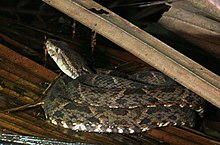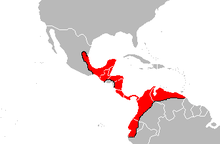Bothrops asper
| Bothrops asper | |
|---|---|
 |
|
| Scientific classification | |
| Kingdom: | Animalia |
| Phylum: | Chordata |
| Subphylum: | Vertebrata |
| Class: | Reptilia |
| Order: | Squamata |
| Suborder: | Serpentes |
| Family: | Viperidae |
| Subfamily: | Crotalinae |
| Genus: | Bothrops |
| Species: | B. asper |
| Binomial name | |
|
Bothrops asper (Garman, 1884) |
|
 |
|
| Geographical range of Bothrops asper. | |
| Synonyms | |
|
|
Bothrops asper is a venomous pit viper species ranging from southern Mexico to northern South America. Sometimes referred to as the "ultimate pit viper", these snakes are found in a wide range of lowland habitats, often near human habitations. Its proximity to human habitations is likely the reason why it is considered more dangerous to humans than others. This species is the main cause of snakebite incidents within its range. No subspecies are currently recognized.
The generic name, Bothrops, comes from the Greek words bothros and ops, which mean "pit" and "face" (or "eye"), respectively. This is a reference to these snakes' highly sensitive heat-detecting pit organs. The specific epithet, asper, which is a Latin word meaning "rough" or "harsh", may allude to the species' keeled dorsal scales.
Some of the common names applied to this snake are terciopelo, fer-de-lance,barba amarilla (Guatemala, Honduras; "yellow beard"), equis (Ecuador & Panama; "x"),taya equis (Colombia), cuaima (Venezuela), nauyaca (México; from Nahuatl nahui, four, and yacatl, nose; "four noses"), and yellow-jaw tommygoff (Belize).
The name fer-de-lance is commonly used in North America to refer to this species, as well as to B. atrox, although B. atrox is more commonly referred to as the "lancehead" in North America. The name fer-de-lance is not used in the countries inhabited by this species. The name terciopelo means velvet in Spanish.
Bothrops species can be distinguished by their broad, flattened heads which are set apart from the rest of their bodies. The head of this snake is light to dark brown or even black. Although usually absent, it may have occipital blotches or streaks that range from indistinct to distinct. The underside is most often pale yellow. This species has different patterns and colors on its dorsal and ventral sides and it exhibits a postorbital stripe. The ventral side is yellow, cream, or a whitish gray, with dark blotches that are more frequent closer to the posterior end. Ventrolaterally, B. asper has interchanging gray scales which are more pale towards the medial line. Dark triangles with pale edges can be seen laterally, which range in number from 18 to 25. Apices either alternate or are reflective of each other over the middorsal line. In the interspaces, there are dark, paravertebral blotches. Specimens may have a yellow zig-zag-shaped line on each side of the body. There is a great variety of colours on its dorsal side: olive, gray, light brown to dark brown, tan or sometimes nearly black. To prevent water loss where they occur in drier regions, this species has more scales.
...
Wikipedia
